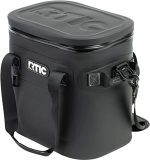While there are a lot of coolers available, many have different features to offer. And because none of them are designed specifically for sailing, there tend to be some better than others. Here’s a list of what makes the best coolers for a sailboat:
Get A Cooler That’s Easy To Carry To The Sailboat
A Good Sailing Cooler Won’t Damage The Boat
Get One The Has A Lid That Seals Well
Get A Cooler With Thick Insulation
Pack Your Cooler Properly
Best Coolers For A Sailboat (Top Picks)
Get A Cooler That’s Easy To Carry Down The Dock
A good sailing cooler is easy to carry down the dock. When going to your boat, you generally have a walk from the car to the boat. And most boat owners will always have the plan to make the least amount of trips back and forth to the car. So when choosing your boat cooler, ensure you can carry it easily. Find one with carrying backpack straps or a shoulder strap. This will make it easy to carry the cooler along with the other boating gear you have. Experienced sailors know how to keep the trips back and forth to the car at a minimum.
 A Good Sailing Cooler Won’t Damage The Boat
A Good Sailing Cooler Won’t Damage The Boat
All boats and especially sailboats will always be moving about in waves. In addition, sailboats will heel over more as the wind gets stronger. The best coolers for sailing will stay in one place and won’t slide around in the boat when heeled over. It’s important to have a cooler that does not damage the boat or someone if it starts to slide. This is why soft coolers are a great choice for boaters. A soft cooler will be able to keep everything cold while also giving the boat owner peace of mind that nothing will get damaged while on the water.
If you prefer a hard cooler, the solution for this is a marine-specific cooler. Marine coolers with rubber will keep your cooler from tossing side to side as the boat tacks and jibes. A cooler that stays in place can make for one of the best coolers for a sailboat.
Get One The Has A Lid That Seals Well
A cheap plastic cooler can give boaters a few headaches. One of them is that the lid simply does not seal well. Cheap coolers also have poor insulation. Between a poor seal and crew members leaving the cooler lid open after they’ve had a “few,” your ice will not last long. And when sailing there’s nowhere convenient to stop for ice!
Get A Cooler With Thick Insulation
Another feature that qualifies coolers as good for sailing is the thickness of the cooler wall. The cooler wall is the negative space between the outside and inside of the cooler. This is an indicator of how well it insulates. The thicker the cooler wall, the longer it will keep things cold. This is why it’s important to find a quality sailing cooler and not settle for something cheap. Cheap coolers can let food get warmer faster and open the opportunity for food poisoning. No one wants that!
Tips For Packing A Cooler To Go Sailing
- Use frozen water bottles to keep your food cold. This will keep any food in the cooler from getting soggy and also give you a nice cold bottle of water if it’s a long day sailing. (Be sure not to fill your water bottle to the top. Water expands when it freezes so give it some room for that.
- Use two coolers: one soft cooler for drinks (use ice) and one hard cooler for food (use frozen water bottles). This will keep your food from getting soggy from melted ice. No one likes a soggy sandwich!
- Get your beverages and food cold before packing. This will make everything stay cold much longer.
Other Recommended Coolers For Sailboats
Backpack Coolers
Backpack coolers are convenient to carry to the boat. They’re great for day sailing with a small number of crew.
Soft Coolers
Soft coolers won’t damage the boat and they can be “wedged” into an opening inside the boat somewhere to keep them from sliding around. These are a popular choice for dinghy and small keelboat sailors.
Hard Coolers
These are great choices for day sailing or weeknight racing on larger keelboats.


















